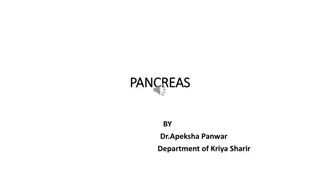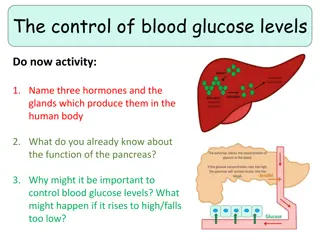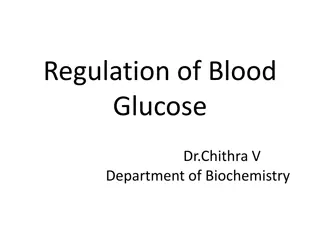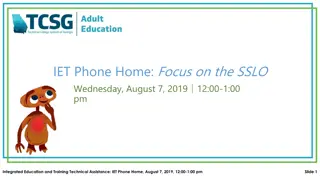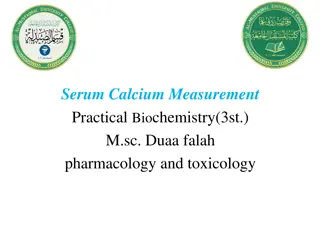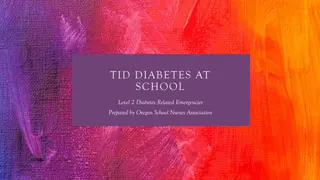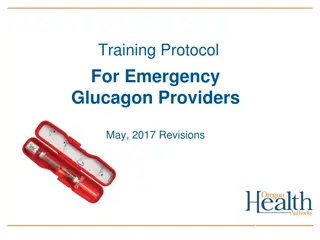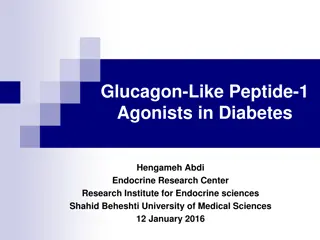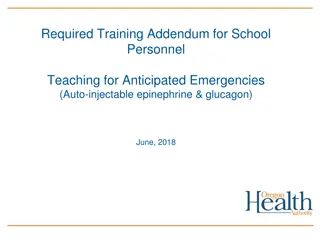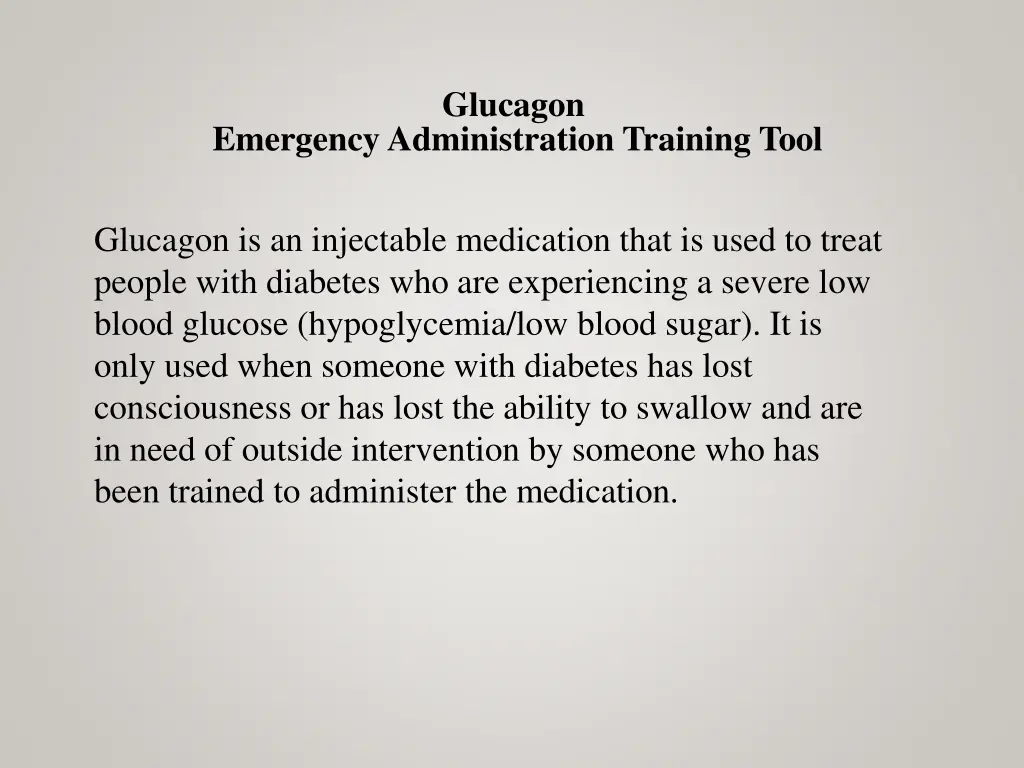
Understanding Glucagon and Diabetes Basics
Learn about the emergency administration of glucagon for severe hypoglycemia in people with diabetes, along with understanding the basics of diabetes, insulin, and the distinction between type 1 and type 2 diabetes. Discover the importance of monitoring blood glucose levels for diabetes management.
Download Presentation

Please find below an Image/Link to download the presentation.
The content on the website is provided AS IS for your information and personal use only. It may not be sold, licensed, or shared on other websites without obtaining consent from the author. If you encounter any issues during the download, it is possible that the publisher has removed the file from their server.
You are allowed to download the files provided on this website for personal or commercial use, subject to the condition that they are used lawfully. All files are the property of their respective owners.
The content on the website is provided AS IS for your information and personal use only. It may not be sold, licensed, or shared on other websites without obtaining consent from the author.
E N D
Presentation Transcript
Glucagon Emergency Administration Training Tool Glucagon is an injectable medication that is used to treat people with diabetes who are experiencing a severe low blood glucose (hypoglycemia/low blood sugar). It is only used when someone with diabetes has lost consciousness or has lost the ability to swallow and are in need of outside intervention by someone who has been trained to administer the medication.
Learning Objectives Participants will learn: Diabetes basic care Symptoms and treatment of hypoglycemia (low blood glucose) Procedure for the emergency administration of glucagon This training will provide you with: an overview of diabetes and basic diabetes care; detailed information on the symptoms and treatment of one of the most frequent short-term complications of diabetes, hypoglycemia (low blood glucose); and information on the skills and knowledge needed to administer glucagon, a life-saving treatment for severe hypoglycemia (low blood glucose).
Diabetes Basics Diabetes is a disease where the body does not produce insulin or does not use insulin properly. Insulin is a hormone normally made by the body. It helps glucose (sugar) enter cells where it can be used for energy. Without insulin, glucose remains in the blood stream and cannot be used for energy by cells. Insulin is a hormone that is produced by the pancreas and released into the blood stream after eating. Its role is to allow glucose (energy from food) to enter the cells of the body so that the cells can have the energy they need. Without insulin, glucose builds up in the blood stream, unable to reach the cells. The cells become starved for energy. Excess glucose in the blood causes many problems for the person with diabetes.
The two most common types of diabetes are type 1 and type 2. We will primarily be discussing type 1 diabetes, which is the most common form of diabetes in children (type 2 is the most common form in adults and is growing more common in older children and adolescents). Autoimmune* Genetics Environmental Obesity Heredity Inactivity More common in adults More common in children In type 1 diabetes, the pancreas stops producing insulin or produces so little insulin that a child must take insulin every day for survival. In type 2 diabetes, the body does not make enough insulin or cannot properly use the insulin it does make. *Autoimmune process an immune response in which the body attacks its own tissues, cells or cell components. In type 1 diabetes, there is an autoimmune destruction of the beta cells of the pancreas, which causes the body to produce very little or no insulin.
Diabetes Basics Patients with diabetes must monitor their blood glucose levels. Safe blood glucose levels are achieved through a careful balance of food intake, exercise and insulin. Insulin and exercise - blood glucose Food - blood glucose Stress, illness or injury - blood glucose
The key to optimal diabetes control is a careful balance of food, exercise, and insulin and/or oral medication (oral medication is for type 2 diabetes only). Generally, insulin/oral medication and exercise/activity makes blood glucose levels go down. Food makes blood glucose levels go up. Several other factors, such as stress, illness or injury, also can affect blood glucose levels. Research has shown that maintaining optimal blood glucose levels can prevent or delay the long- term complications of diabetes (heart attack, stroke, blindness, kidney failure, nerve disease, and amputations of the foot or leg).
The most common short-term complications for patients with diabetes are hyperglycemia (high blood glucose), and hypoglycemia (low blood glucose). Both can usually be managed with a well-thought-out Diabetes Medical Management Plan developed by the patient's personal health care team. (primary care provider and parent)
Hyperglycemia occurs anytime the blood glucose is above the target range. It is caused by having too much glucose and/or not enough insulin in the body. The two main reasons for having hyperglycemia are poor blood glucose control and getting sick. When a patient gets sick, glucose levels may become unpredictable. In many cases, blood glucose levels increase.
Symptoms of hyperglycemia include: Urinating large amounts. Excessive thirst. Feeling tired. Frequent hunger. Dry mouth. Weight loss. Blurred vision. Recurrent infections (e.g., urinary infections, skin infections)
Hypoglycemia (Low Blood Glucose) Hypoglycemia poses the most immediate risk to a student with diabetes because onset is sudden, it is not always preventable and may progress to unconsciousness and convulsions if left untreated. Possible Causes: Too much insulin Too little food or delayed meal or snack Extra physical activity Illness Medications May occur for no apparent reason
Hypoglycemia means that the level of glucose in the blood has dropped below target range. Hypoglycemia or lows occur whenever there is too much insulin in the body for the amount of glucose. However, while any hypoglycemia episode calls for urgent action, it can often be prevented from becoming an emergency. Most hypoglycemic episodes are quite mild and symptoms resolve within 10- 15 minutes of consuming a quick acting carbohydrate such as fruit juice or non-diet soda. Recognizing early symptoms and always having access to appropriate foods are the surest way to prevent an emergency. Sometimes there is no explanation for why hypoglycemia occurs.
Early Signs and Symptoms (Mild to Moderate): Shaking or Trembling: A common early sign, often due to a release of adrenaline. Sweating: Excessive sweating, even in cool environments, can be a warning sign. Dizziness or Lightheadedness: This can occur as the brain struggles to get enough glucose. Hunger or Nausea: The body's need for glucose can cause intense hunger. Fast Heart Rate: The body's attempt to compensate for low blood sugar can lead to a rapid heartbeat. Irritability or Anxiety: Low blood sugar can affect mood and behavior. Pale Skin (Pallor): Reduced blood flow to the skin can cause a pale appearance. Blurry Vision: Changes in vision can occur as blood sugar drops. Headache: A headache can be a symptom of hypoglycemia.
Severe Signs and Symptoms (If Uncorrected): Confusion or Difficulty Concentrating: The brain relies on glucose for energy, and low levels can cause impaired cognitive function. Unusual Behavior: People may act strangely or display inappropriate behavior. Slurred Speech: Difficulty speaking can be a sign of severe hypoglycemia. Loss of Coordination: Clumsiness or difficulty with movement can occur. Seizures: In severe cases, low blood sugar can trigger seizures. Loss of Consciousness (Passing Out) or Coma: If blood sugar levels drop too low and remain low, unconsciousness or coma can occur. Death: In the most severe cases, hypoglycemia can be fatal if not treated promptly.
The symptoms of hypoglycemia vary from one individual to another. Also, they may vary for one individual, from one episode to another. The symptoms of mild hypoglycemia are the first alert that the body is in a state of low glucose. Mild hypoglycemia can usually be treated easily and effectively. However, if not treated promptly a mild hypoglycemic reaction can quickly progress to a severe state or condition. The important thing to remember is that early recognition and intervention is the best strategy to prevent progression to more severe symptoms. Among patients with type 2 diabetes, mild hypoglycemia is common, but severe episodes are rare, even among those who are taking insulin. Still, all patients who are intensively controlling glucose levels should be aware of warning symptoms for hypoglycemia.
Severe Hypoglycemia If a patient exhibits unconsciousness or unresponsiveness, seizures (convulsions), or is unable to swallow, this is an EMERGENCY: It is virtually impossible to overdose on glucagon and therefore, always safer to treat in order to avoid the serious dangers of not treating.
Responding to Severe Hypoglycemia If severe hypoglycemia develops, a LIFE- SAVING injection of glucagon (a hormone that raises blood glucose levels) must be given. Glucagon is a hormone made in the pancreas. It acts in the liver to release stored glucose. Glucagon is available to be given as an injection in an emergency kit.
Glucagon Kit Storage Management Plan, the kit should be: accessible to trained personnel stored at room temperature monitored for expiration date The glucagon kit s expiration date should be checked. Do not administer if expired, discolored, or does not dissolve well. Expired glucagon emergency kits can be used for future training sessions.
Emergency Kit Contents: 1 mg of freeze-dried glucagon (Vial)1 ml of water for reconstitution (Syringe) Combine glucagon and water immediately before use and discard any unused portion after injection.
This previous photo shows the inside of the two brands of glucagon emergency kits currently available. The red one is produced by Lilly and is known as Glucagon, and the orange one is produced by Novo Nordisk and is sold under the brand name GlucaGen. Be aware that either of these kits may be used in a hypoglycemic emergency. Within the glucagon kit are: Instructions for that particular kit, a syringe pre-filled with a saline solution, and a vial of powdered glucagon. Glucagon must be injected. Combine the glucagon for injection immediately before use by following the instructions that are included with the glucagon kit and dispose of any unused portions after injection.
FIRST STEPS Position patient safely on side for comfort and protection from injury. NEVER attempt to place ANYTHING into the patient's mouth. Check the patients Blood Glucose Level. Follow NYS DOH EMS Collaborative Protocols for Hypoglycemia. Check patients Blood Glucose Level. If level is less the 60mg/dL then continue with setting up for Glucagon Injection. If >60mg/dL then the patient does not fit the requirement of this pilot program. Disconnect insulin pump if present
PREPARATION Flip cap off vial (glass bottle) of glucagon dry powder. Remove hard plastic cap and grey rubber cap from syringe. Before administering glucagon, remember to check the expiration date and check to be sure that you do in fact have the right medication. Inside the emergency kits, you will find easy to follow, illustrated instructions.
MIXING SOLUTION Insert needle through rubber stopper on vial of glucagon and inject entire contents of syringe into vial of powder. Without removing the syringe, hold syringe and vial in one hand and gently shake until all powder is dissolved and solution is clear. The powder should not be mixed with the solution until just before it is injected during a hypoglycemic emergency Bubbles or foam may be visible as a result of shaking.
WITHDRAWING SOLUTION Inspect. Solution must be clear and colorless. Slowly withdraw the amount of solution from the vial into the syringe as specified in the Hypoglycemic Pilot Protocol. Withdraw the full amount of glucagon back into syringe.
INJECTING GLUCAGON Clean injection site on buttock, upper arm, or thigh with alcohol swab, if available. Pinch the skin at the site of injection, hold syringe like a pen and quickly insert needle at a 90 into cleansed area; inject glucagon solution. If it is not possible to remove clothing in a timely manner, glucagon may be injected through clothing if necessary.
INJECTING GLUCAGON Withdraw needle, then apply light pressure at injection site. Discard needle into a sharps container or, if unavailable, back into its case. Do not recap needle. Any patient >20 kg 1mg dose
AFTER INJECTING It may take 10-15 minutes for the patient to regain consciousness. Vomiting may occur - keep the patient positioned on side to prevent choking. Glucagon will increase glucose concentration in the blood in about 10-15 minutes. Be sure to keep the patient positioned on his/her side since vomiting can occur.
NEXT STEPS Administering Glucagon: Monitor for signs of improvements along with continued assessment of the patient airway and vital signs Re-check the patients blood sugar during transport to the hospital.
Don't Be Surprised If. . . The patient does not remember being unconscious or is incoherent or lethargic. The patient feels nauseated, vomits, or has a headache.
Considerations Recovery time from a severe hypoglycemic episode varies according to the duration and level of the blood glucose prior to treatment. Some signs and symptoms, such as headache, may persist for several hours, although the blood sugar level is satisfactory. Continued monitoring is important. Atthis point, please demonstrate administration of glucagon (if practice kits or expired kits are available) and allow participants to review the process aloud and practice the glucagon administration procedure.
QUICK REVIEW Mild to moderate hypoglycemia can be treated with a quick acting source of carbohydrate (15 grams). Signs of severe hypoglycemia include: Unconsciousness Seizures Inability to swallow
QUICK REVIEW Continued: Severe hypoglycemia is a medical emergency requiring Immediate administration of glucagon. Treat, then follow the protocol for medical emergency care.



